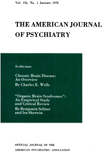Abstract
The EGGs of 1,593 neuropsychiatric cases are analyzed and the tracings are classified as "normal" or "abnormal." "Abnormality" is defined as activity with a predominant frequency outside the range of 8 to 12 per second or a tendency to change greatly with overbreathing. This criterion is applied to all records regardless of age or clinical condition. "Abnormal" records are further classified as slow, fast, and mixed slow and fast.
The percentage of "abnormal" records found in the various neuropsychiatric conditions varies from 22 per cent in alcoholic psychosis to 54 per cent in senile and artericsclerotic disorders. The order is as follows: alcoholic psychosis, 22 per cent; Schizophrenia, 23 per cent; psychopathic personality and behavior disorders, 31 per cent; manic-depressive depressed, 31 per cent; psychoneurosis, 34 per cent; manic-depressive manic, 42 per cent; psychosis with mental deficiency, 50 per cent; involutional psychosis, 51 per cent; senile and arteriosclerotic psychosis, 54 per cent. A control group primarily between 20 to 30 years of age has 10 per cent abnormal EEGs.
Involutional psychosis and manic-depressive depressed conditions are conspicuous because of a large amount of fast activity, whereas senile and arteriosclerotic psychosis, psychosis with mental deficiency, and psychopathic personality and behavior disorder are associated with a large amount of slow activity.
The very wide range over which the various neuropsychiatric conditions are distributed makes it necessary to study the incidence of electroencephalographic abnormality as a function of age. When this is done, the relationship between percentage abnormality and age is found to be a hyperbolic curve with greatest abnormality in youth and old age, and least abnormality between 25 and 45 years. The changes of incidence of electroencephalographic abnormality with age are so great that the factor of age cannot be neglected in the evaluation of the EEG. Furthermore, marked variations of more specific types of electroencephalographic abnormality with age are also found. For example, the incidence of slow activity falls rapidly with increasing age, from 20 per cent under 15 years to 5 per cent at age 45 to 55; and beyond this the incidence of slow activity rises. On the other hand, a rapidly rising incidence of abnormal fast activity occurs with increasing age, from 4 per cent under 15 years to 20 per cent at age 45 to 55, with a probable decline beyond 55 years.
The electroencephalographic findings in the various neuropsychiatric conditions are largely explained by changes associated with age. This makes it necessary to readjust our previous ideas of normality and abnormality in the classification of EEGs so as to take into full consideration the major changes and trends associated with age. In this regard, the present review of a large and diversified group of cases covering a wide age range will provide preliminary standards of comparison and may be useful as a guide to further study along the same lines.

